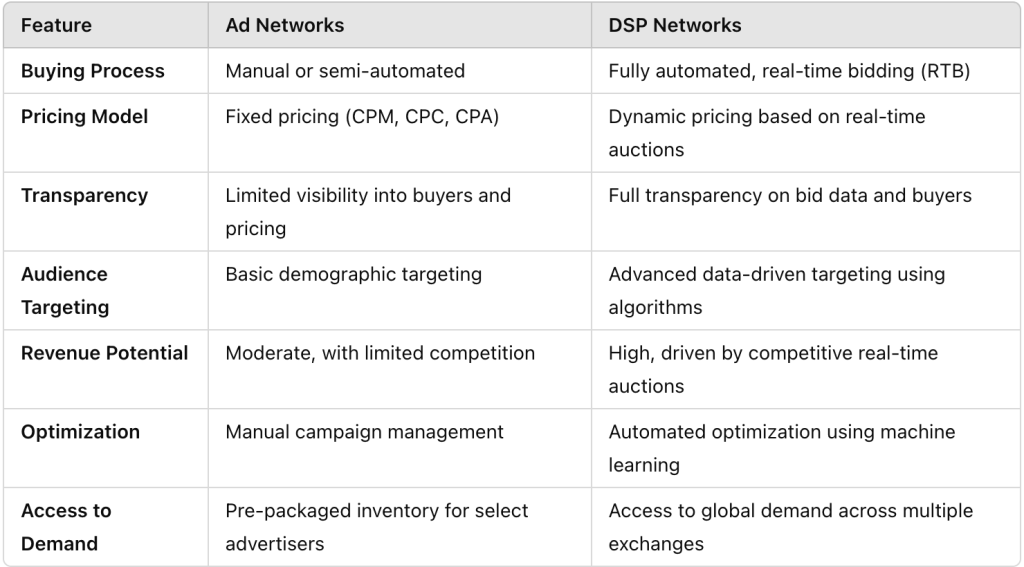In the ever-evolving world of digital advertising, the distinction between Demand-Side Platforms (DSPs) and Ad Networks can seem blurry, especially as both play crucial roles in connecting advertisers with publishers. However, understanding the key differences between these platforms is vital for publishers aiming to optimize their monetization strategies.
While Ad Networks were once the go-to for selling inventory, the rise of DSP Networks has ushered in a new era of programmatic efficiency, transparency, and revenue potential. In this guide, we’ll break down the differences between DSP networks and traditional ad networks, explore their respective impacts on publisher revenue, and offer actionable insights to help you choose the right mix for your monetization strategy.
What is an Ad Network?
An Ad Network acts as an intermediary between publishers and advertisers, aggregating ad inventory from multiple publishers and selling it to advertisers in bundles. This model simplifies the ad buying process for advertisers by offering pre-packaged inventory, often based on audience demographics, niche markets, or content categories.
Key Features of Ad Networks:
- Aggregated Inventory: Combines ad spaces from various publishers and offers them to advertisers as a package.
- Fixed Pricing Models: Often relies on static pricing models like CPM, CPC, or CPA.
- Limited Transparency: Publishers typically have limited visibility into who’s buying their inventory or how ads are being served.
- Manual Campaign Management: Many ad networks still require manual setup and management of campaigns.
While ad networks provide a straightforward way to monetize unsold inventory, they often lack the flexibility, transparency, and real-time optimization that modern publishers require.
What is a DSP Network?
A Demand-Side Platform (DSP) Network is a technology platform that allows advertisers to buy digital ad inventory across multiple exchanges and websites in real-time through programmatic auctions. DSPs use data-driven algorithms to evaluate available impressions and place bids, ensuring advertisers reach their target audiences efficiently.
Key Features of DSP Networks:
- Real-Time Bidding (RTB): Impressions are bought and sold in real-time, maximizing competition and revenue potential.
- Data-Driven Targeting: Uses rich audience data for hyper-targeted ad placements, leading to better engagement and higher eCPMs.
- Transparency and Control: Publishers have greater visibility into who’s buying their inventory, bid values, and campaign performance.
- Automated Optimization: Leveraging machine learning algorithms, DSPs continuously optimize pricing and inventory allocation.
DSP networks represent the future of digital advertising, offering publishers more control, higher transparency, and better revenue opportunities compared to traditional ad networks.
DSP Networks vs. Ad Networks: Key Differences for Publishers

How DSP Networks Can Revolutionize Publisher Monetization
- Higher CPMs Through Increased Competition
DSPs introduce real-time competition among advertisers, driving up bid prices and resulting in higher CPMs for publishers. - Better Fill Rates with Global Demand
DSP networks connect publishers to a vast pool of global advertisers, improving fill rates and reducing unsold inventory. - Enhanced Ad Quality and User Experience
With data-driven targeting, DSPs ensure that relevant, high-quality ads are served, improving user engagement and overall site experience. - Greater Control and Transparency
Publishers have full visibility into who is buying their inventory, how much they’re paying, and how ads are performing—something traditional ad networks often lack. - Automated Yield Optimization
DSPs use machine learning to optimize inventory pricing and allocation in real-time, ensuring publishers maximize revenue without manual intervention.
When Should Publishers Use DSP Networks vs. Ad Networks?
Use DSP Networks If You Want To:
- Maximize revenue through real-time auctions and dynamic pricing.
- Gain full transparency into ad performance and buyer behavior.
- Leverage advanced audience targeting for better engagement.
- Automate optimization with data-driven algorithms.
Use Ad Networks If You Want To:
- Quickly monetize unsold or remnant inventory with minimal setup.
- Access niche or industry-specific advertisers through packaged deals.
- Simplify the ad buying process for smaller, less complex campaigns.
Pro Tip: Many successful publishers use a hybrid approach, leveraging both DSP networks and ad networks to ensure comprehensive coverage of their inventory and to optimize revenue streams across all ad types and formats.
Industry Insights: The Shift from Ad Networks to DSP Networks
According to eMarketer, global programmatic ad spending via DSPs is expected to reach $250 billion by 2025, reflecting the growing dominance of DSP networks in the digital advertising ecosystem. IAB’s 2024 Programmatic Report highlights that 70% of publishers now prioritize DSP integrations over traditional ad networks due to better transparency, higher CPMs, and more efficient inventory management.
PubMatic’s SSP Trends Report indicates that publishers utilizing multiple DSPs see an average 35% increase in revenue compared to those relying solely on ad networks. Furthermore, AdExchanger reports that supply-path optimization (SPO) and first-party data integration are driving factors in the shift toward DSP networks.
How WaardeX Helps Publishers Maximize Revenue with DSP Networks
At WaardeX, we empower publishers to harness the full potential of DSP networks while maintaining control over their inventory and revenue streams. Our cutting-edge SSP technology seamlessly integrates with top DSPs, ensuring publishers get the most out of every impression.
- Seamless DSP Integration
Connect with leading DSP networks through WaardeX’s platform to access premium demand and drive up CPMs. - Real-Time Yield Optimization
Our machine learning algorithms analyze real-time data to optimize pricing and inventory allocation, ensuring maximum revenue. - Comprehensive Analytics Dashboard
Gain full transparency into ad performance, buyer behavior, and bid dynamics with our intuitive dashboard. - Header Bidding Support
WaardeX’s header bidding capabilities ensure DSPs compete alongside other demand sources, maximizing competition and revenue. - Dedicated Account Management
Our experienced team provides personalized support to help publishers navigate the DSP ecosystem and implement strategies for sustainable growth.

Conclusion
Understanding the differences between DSP networks and ad networks is crucial for publishers aiming to optimize their monetization strategies. While ad networks offer simplicity and quick monetization, DSP networks provide the transparency, control, and real-time optimization needed to maximize revenue in today’s competitive digital landscape.
With WaardeX as your partner, you can leverage the best of both worlds, ensuring your inventory is always performing at its peak potential. Ready to optimize your monetization strategy? Contact WaardeX today to learn how we can help you maximize revenue through advanced DSP integrations and programmatic solutions.
